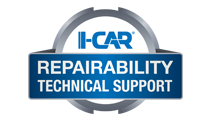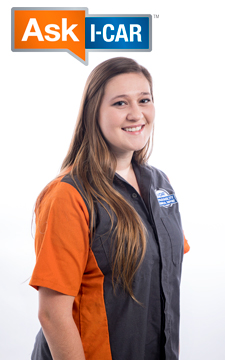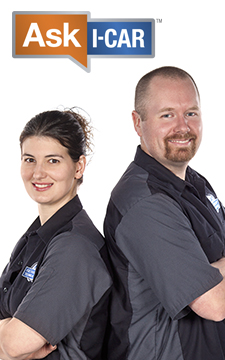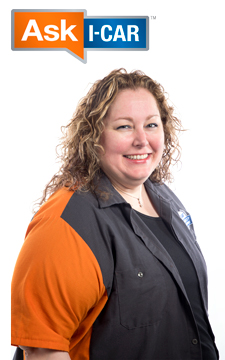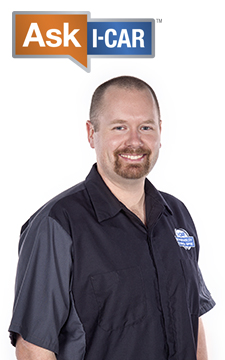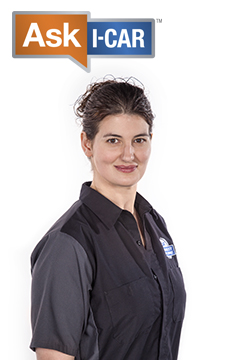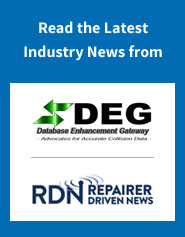Oil Spill At The I-CAR Tech Center
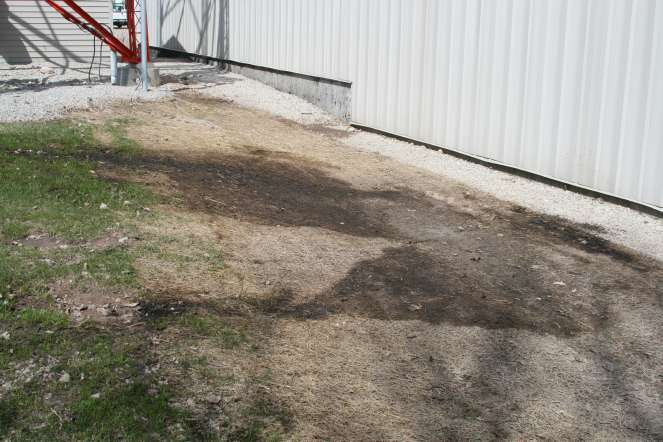 Figure 1 - The spill was discovered in the spring after the snow melt.
Figure 1 - The spill was discovered in the spring after the snow melt. A small motor oil spill incident at the I-CAR Tech Center in Appleton, Wisconsin in the spring of 2011 has raised our awareness of the many considerations involved with a material spill into the environment. What started as an accidental collision between a snowplow and a 55-gallon drum of waste oil on an adjoining property resulted in an experience we would never want to repeat.
There were several steps and decisions that had to be made to assure proper cleanup. What was more stressful than what we knew about the incident was what was unknown. How far had the spill traveled? Was the groundwater contaminated? What public agencies might have to be involved? How much was this all going to cost?
We thought we'd share our experience to perhaps benefit another facility that might encounter a similar incident.
Discovery and Initial Steps
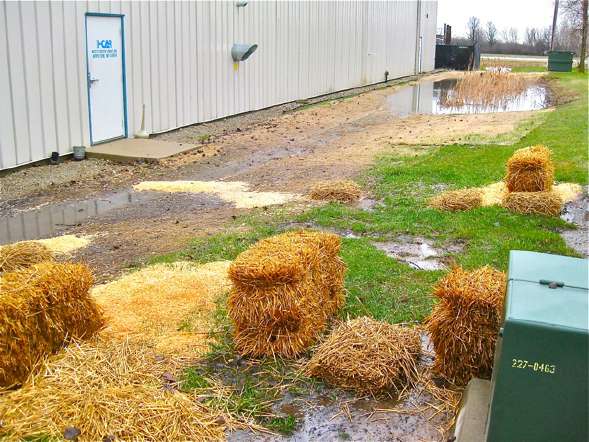 Figure 2 - Sawdust and hay bales were first added to the site for containment.The spill was discovered in mid-April as the snow melted (see Figure 1). A 55-gallon drum of motor oil in a parking lot near the Tech Centre property was damaged by a snowplow during the winter. Some 30 gallons of spilled oil was carried off the pavement along with the melting snow. A rainstorm further aggravated the situation.
Figure 2 - Sawdust and hay bales were first added to the site for containment.The spill was discovered in mid-April as the snow melted (see Figure 1). A 55-gallon drum of motor oil in a parking lot near the Tech Centre property was damaged by a snowplow during the winter. Some 30 gallons of spilled oil was carried off the pavement along with the melting snow. A rainstorm further aggravated the situation.
The company that provided the snow plowing offered to immediately come in and dig out all of the contaminated soil and stone, take it to a local landfill, and replace it with fresh new material. The offer was put on hold while we sought legal and other professional advice. We were informed that because we discovered the contamination and it was on our property, we were responsible for immediate containment to minimize environmental impact. We were also responsible for addressing possible downstream contamination.
A local civil engineering and environmental firm was hired to assess the spill. Their observation showed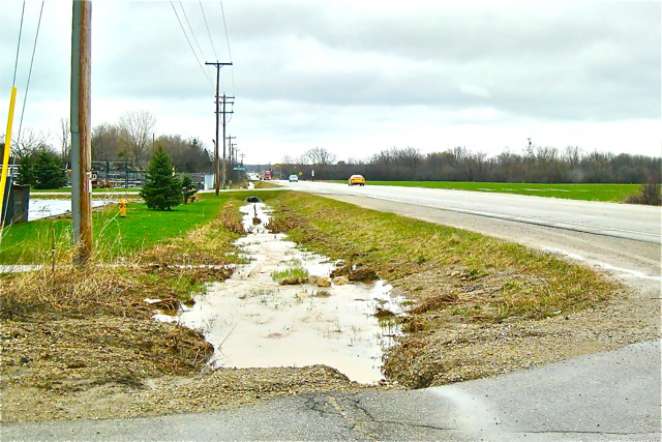 Figure 3 - There was a fear that the spill had migrated into a nearby drainage ditch. "visual and olfactory evidence of petroleum contamination." That initial observation was verified by a core sampling. It was recommended that wood chips and hay bales be layered on the visible spill areas in an attempt to contain it (see Figure 2). The engineering firm added a ten-foot absorbent boom to the containment efforts. They were also required to inform the Wisconsin Department of Natural Resources Regional Spills Coordinator. The Wisconsin Department of Natural Resources was the only public agency that had to be involved with the incident. Numerous photographs were taken of the site, including aerial photographs. An early concern was that the oil had leaked into a ditch containing surface water (see Figure 3). Whether the oil had contaminated any groundwater was unknown until weeks later.
Figure 3 - There was a fear that the spill had migrated into a nearby drainage ditch. "visual and olfactory evidence of petroleum contamination." That initial observation was verified by a core sampling. It was recommended that wood chips and hay bales be layered on the visible spill areas in an attempt to contain it (see Figure 2). The engineering firm added a ten-foot absorbent boom to the containment efforts. They were also required to inform the Wisconsin Department of Natural Resources Regional Spills Coordinator. The Wisconsin Department of Natural Resources was the only public agency that had to be involved with the incident. Numerous photographs were taken of the site, including aerial photographs. An early concern was that the oil had leaked into a ditch containing surface water (see Figure 3). Whether the oil had contaminated any groundwater was unknown until weeks later.
Cleanup
A couple weeks after the initial observation, it was agreed that the snow plowing company that  Figure 4 - The excavation had to be done by hand due to the obstructions in the area.first made the offer to remove the spill would be allowed to do so, but only under the guidance and direction of the civil engineering and environmental firm.
Figure 4 - The excavation had to be done by hand due to the obstructions in the area.first made the offer to remove the spill would be allowed to do so, but only under the guidance and direction of the civil engineering and environmental firm.
Excavation began in May. Due to the electrical and telecommunications underground conflicts, it all had to be dug out by hand (see Figure 4). Nearly six tons of soil were excavated, loaded, and sent to a qualified landfill. The depth of the excavation varied, but it was no deeper than 6". By late May, the spill was entirely contained. By early June, all affected soil was removed. This had to be confirmed by another round of soil samples.
The final 13-page report by the civil engineering and environmental firm, in color and spiral bound, contained the entire testimony since the firm was hired. An appendix included all the photos, lab analysis charts, and statements from everyone involved. The firm's final observation was summed up in the statement: "Given the amount of oil released and the amount of contaminated material hauled away, the environment has been restored to the extent practicable."
The excavated area had to be backfilled with clean topsoil and seeded. The snow plowing company handled all the expenses for the spill cleanup, except for the initial core sampling that I-CAR had authorized on its own. One of the last steps was receiving a final signoff from the Wisconsin Department of Natural Resources Regional Spills Coordinator. That two-page report did not come until weeks after the final engineering report was printed and delivered. The DNR report stated that the spill was cleaned up to the extent practicable, and no further cleanup is needed. The groundwater was not contaminated. The spill had not migrated into the drainage ditch. It was also noted that no citations had to be issued in connection with the spill. Final landscaping of the area could then begin. The final cost to I-CAR was much less than what we had feared.
Suggestions for a Similar Issue
In case a facility encounters a similar issue, we can only suggest being forthright with the environmental authorities. It will do no good to try and hide the incident or ignore the issue. Contact the local agency and ask, "What do I need to do about an outdoor oil spill?" Similar to a vehicle owner involved in their first collision, a facility owner doesn't know what to do when an accident occurs.
We took the initiative to contact the local engineering firm to do a core sample. We then asked the firm what do we do next? Their advice was to take every effort to contain the spill. Being upfront about the incident is always the best approach.
Conclusion
The affair required us to collaborate with legal, engineering, and environmental firms that we had little or no contact with previously. As it turned out, the spill did not contaminate surrounding groundwater. It was contained and cleaned up in a relatively short time. We hope this story of our experience will help whatever contaminant spill situation you may encounter.
This article first appeared in the March 6, 2012 edition of the I-CAR Advantage Online.
Related I-CAR Courses
Article validated in 2025
-
Toyota/Lexus/Scion Position Statement: Pre- and Post-Repair System Scanning
Thursday, 28 July 2016
As the industry continues to ask if pre- and post-repair system scanning is necessary, Toyota/Lexus/Scion provides their answer.
-
Pre- and Post-Repair System Scanning Statements
Wednesday, 9 January 2019
Are you wondering if a particular OEM or organization has a published statement on pre-repair and post-repair scanning? We have compiled a list of most of the statements on the subject, so you can...
-
ADAS, Calibration, And Scanning Article Hotspot
Monday, 14 January 2019
Since advanced driver assistance systems (ADAS), scanning, and calibration first started becoming relevant, members of the collision repair industry have required as much knowledge as possible on...
-
Honda/Acura Position Statement: Pre- and Post-Repair System Scanning - UPDATE
Wednesday, 22 May 2019
Honda /Acura has updated their position statement on pre- and post-repair scanning to give more clarification on what is expected for scanning.
-
BMW Position Statement: Pre- and Post-Repair System Scanning - UPDATE
Friday, 10 April 2020
BMW has released a position statement related to pre- and post-repair system scanning. The statement applies to All vehicles equipped with on board diagnostics II (OBD II).
-
Quickly Identifying Outer Quarter Panels w/Rolled Hem Flanges
Monday, 5 March 2018
The I-CAR best practice article, Recycled Outer Quarter Panels w/Rolled Hem Flanges has gotten a lot of interest from the collision repair industry. It’s important to know which vehicles are...
-
General Motors Position Statement: Pre- and Post-Repair System Scanning
Friday, 21 October 2016
As the industry continues to ask, are pre- and post-repair scans necessary, General Motors provides their answer.
-
Restraints Wiring Repairs
Monday, 23 May 2016
Over the past few months, we've been sharing OEM position statements on restraints wiring repairs. Now we're bringing them all together in one place for easy reference.
-
FCA/Stellantis Position Statement: Pre- and Post-Repair System Scanning
Thursday, 9 June 2016
FCA/Stellantis has released a position statement related to pre- and post-repair system scanning.
-
Typical Calibration Requirements For Forward Radar Sensors
Wednesday, 12 October 2016
Technicians should be aware of what’s required to keep advanced driver assistance systems (ADAS) running safely after a collision. Whether that be aiming a camera, which can cause a system to not...
-
Structural Sectioning Procedures: Ford/Lincoln - UPDATE
Friday, 19 December 2025
Ask I-CAR receives many technical inquiries referring to sectioning. The collision repair industry wants to know where can you section, does the OEM have a sectioning procedure, and where can I find the...
-
Body Repair Manual Symbols: Hyundai
Wednesday, 17 December 2025
While looking at repair procedures in a body repair manual (BRM) you may notice that symbols are used to indicate specific operations or parts to be used during the repair process. Most BRMs provide a...
-
Body Repair Manual Symbols: Genesis
Wednesday, 17 December 2025
While looking at repair procedures in a body repair manual (BRM) you may notice that symbols are used to indicate specific operations or parts to be used during the repair process. Most BRMs provide a...
-
App-Based Connected Services Considerations: BMW
Wednesday, 10 December 2025
Have you had an experience where the vehicle notified the owner that it was being moved while it was in your repair facility? App-based connected services are available from many vehicle makers and...
-
Digital Key Considerations: BMW
Wednesday, 10 December 2025
The intermingling of technology and automobiles continues, with digital key offerings from most vehicle makers. Digital keys utilize smartphone technology to expand vehicle access and owner...
-
I-CAR Repairers Realm: RTS 2025 Year In Review - Coming Soon
Tuesday, 9 December 2025
I-CAR is having a discussion on the Repairability Technical Support (RTS) 2025 year in review.
-
Mercedes-Benz Vehicles On The RTS OEM Calibration Requirements Search
Thursday, 4 December 2025
Mercedes-Benz models are now listed in the OEM Calibration Requirements Search page on the RTS website. You're going to notice a difference between other vehicle search results and Mercedes-Benz...
-
I-CAR Repairers Realm - New In 2026: Mixed Attachment Methods And Steel Sectioning Recertification - Now Available
Monday, 1 December 2025
I-CAR had a discussion on the new Mixed Attachment Methods course launching in 2026.
-
Repairer Driven News: SCRS OEM Collision Repair Technology Summit Sessions
Monday, 1 December 2025
Repairer Driven News published three articles highlighting safety inspection topics that took place during the Collision Repair Specialists (SCRS) OEM Collision Repair Technology Summit at the 2025...
-
I-CAR Audi Collision Repair And Electromechanical Repair Overview Courses
Tuesday, 25 November 2025
I-CAR has developed courses that provide an overview of collision repair and electromechanical repair for current Audi vehicles.
- 2025
- December 2025 (9)
- November 2025 (11)
- October 2025 (13)
- September 2025 (11)
- August 2025 (12)
- July 2025 (11)
- June 2025 (11)
- May 2025 (11)
- April 2025 (13)
- March 2025 (12)
- February 2025 (11)
- January 2025 (12)
- 2024
- December 2024 (8)
- November 2024 (10)
- October 2024 (13)
- September 2024 (10)
- August 2024 (12)
- July 2024 (11)
- June 2024 (9)
- May 2024 (13)
- April 2024 (12)
- March 2024 (12)
- February 2024 (12)
- January 2024 (9)
- 2023
- December 2023 (8)
- November 2023 (12)
- October 2023 (11)
- September 2023 (11)
- August 2023 (12)
- July 2023 (9)
- June 2023 (11)
- May 2023 (12)
- April 2023 (11)
- March 2023 (12)
- February 2023 (10)
- January 2023 (11)
- 2022
- December 2022 (11)
- November 2022 (12)
- October 2022 (11)
- September 2022 (13)
- August 2022 (11)
- July 2022 (10)
- June 2022 (13)
- May 2022 (11)
- April 2022 (12)
- March 2022 (10)
- February 2022 (11)
- January 2022 (13)
- 2021
- December 2021 (13)
- November 2021 (11)
- October 2021 (13)
- September 2021 (14)
- August 2021 (12)
- July 2021 (15)
- June 2021 (17)
- May 2021 (11)
- April 2021 (14)
- March 2021 (20)
- February 2021 (14)
- January 2021 (14)
- 2020
- December 2020 (13)
- November 2020 (17)
- October 2020 (12)
- September 2020 (14)
- August 2020 (11)
- July 2020 (18)
- June 2020 (14)
- May 2020 (14)
- April 2020 (19)
- March 2020 (12)
- February 2020 (13)
- January 2020 (14)
- 2019
- December 2019 (13)
- November 2019 (19)
- October 2019 (25)
- September 2019 (20)
- August 2019 (22)
- July 2019 (23)
- June 2019 (20)
- May 2019 (19)
- April 2019 (20)
- March 2019 (20)
- February 2019 (18)
- January 2019 (17)
- 2018
- December 2018 (18)
- November 2018 (19)
- October 2018 (17)
- September 2018 (16)
- August 2018 (21)
- July 2018 (20)
- June 2018 (21)
- May 2018 (17)
- April 2018 (19)
- March 2018 (21)
- February 2018 (15)
- January 2018 (20)
- 2017
- December 2017 (13)
- November 2017 (15)
- October 2017 (19)
- September 2017 (20)
- August 2017 (19)
- July 2017 (18)
- June 2017 (19)
- May 2017 (18)
- April 2017 (13)
- March 2017 (18)
- February 2017 (10)
- January 2017 (11)
- 2016
- December 2016 (9)
- November 2016 (14)
- October 2016 (21)
- September 2016 (10)
- August 2016 (11)
- July 2016 (8)
- June 2016 (10)
- May 2016 (5)
- April 2016 (11)
- March 2016 (12)
- February 2016 (10)
- January 2016 (8)
- 2015
- December 2015 (9)
- November 2015 (6)
- October 2015 (8)
- September 2015 (7)
- August 2015 (11)
- July 2015 (7)
- June 2015 (5)
- May 2015 (7)
- April 2015 (8)
- March 2015 (8)
- February 2015 (9)
- January 2015 (10)
- 2014
- December 2014 (12)
- November 2014 (7)
- October 2014 (11)
- September 2014 (10)
- August 2014 (9)
- July 2014 (12)
- June 2014 (9)
- May 2014 (12)
- April 2014 (9)
- March 2014 (6)
- February 2014 (1)
- January 2014 (26)
